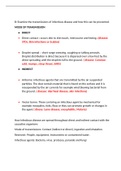B: Examine the transmissions of infectious disease and how this can be prevented.
MODE OF TRANSMISSION
• DIRECT
• Direct contact : occurs skin to skin touch, intercourse and kissing. (disease:
STDs, Skin infections or Scabies)
• Droplet spread : short range sneezing, coughing or talking aerosols.
Droplet distribution is direct because it is dispersed over a few feet by the
direct spreading until the droplets fall to the ground. ( disease: Common
cold, mumps, strep throat, SARS)
• INDIRECT
• Airborne: infectious agenta that are transmitted by the air suspended
particles. The dust contain material that is found on the surface and it is
resuspended by the air currents for example wind blowing bacterial from
the ground. ( disease: diarrheal disease, skin infections)
• Vector borne: These can bring an infectious agent by mechanical for
example mosquitos, ticks, fleas or they can promote growth or changes in
the agent ( disese: Lyme disease, encephalitis, Malaria)
How infectious disease are spread throughout direct and indirect contact with the
causative organisms
Mode of transmissions: Contact (indirect or direct), ingestion and inhalation.
Reservoir: People, equipment, instruments or contamined water.
Infectious agents: Bacteria, virus, protozoa, paraside and fungi
,Host: any person that is baby, eldery, people with weakened immune system,
children or unimmunized people.
Entry: Skin, incisions, respiratory tract, mucous membrane, tubes or catheteres,
eyes.
Exit: Open wounds, splatter of body fluids or aerosols
There are so many mode of transmissions of disease for examples:
Waterbone and foodborne Cholera and Typoid fever
Air borne SARS and Mumps
Vector borne Yellow fever, dengue and Malaria
Animal borne Leptospirosis
Blood borne HIV/AIDs
SID sexually transmitted disease Fungal infections
Recreational H2O CLM and Legionellosis
Infectious disease : Are disorders caused by small organisms for example: viruses,
bacteria, fungi or parasites. Many microorganisms live on or in our bodies. These
organisms are harmful, or beneficial. Moreover, under certain conditions, small
organisms may causes some sort of diseases. Therefore, this diseases can
transmit those infectious disease from person-to-persons. Some disease are
caused by animals or other insects. Other diseases may develop due to drinking
contaminated water or eating food (that is not washed properly), or because of
the exposure to the small organisms found in the environment.
Infections transmissions is the spread of infection from host to host. There are 2
main ways of how the infection can be transmitted: DIRECT or INDIRECT contact.
Direct contact is the contact that is directly from an infected individal and can be
anything for example touching, sexual contact, airborne droplets or kissing.
Indirect contact transmission occurs wen there is no person-to-person contact for
example is being infected with salmonella from eating raw meat, raw eggs.
Infections are spread directy from a infected individual to a healthy individual.
Contact transmission is the most usual form that there is. Contact transmission is
, a direct trasmissions that can infect a non-infected individual. Once the bactera,
germ, virus is on the host this is when the microorganisms enter the body and
with due time, the person start show the symptoms.
The blood contact is also a form or direct contact, coming into contact with an
infected host’s blood can cause the patient to become infected. As an example, if
your partner has a cut on the hand and their blood enters your body.
Being bitten by an vector an animal or being scratched by an animal can transmit
infections, because the animals can have bacteria on their claws or teeth because
the animal who has the infectious disease when scratch a human may cause an
open wound for bacteria to enter in the human’s system and obviously lead to an
infection which means that is an example of direct transmissions, but it can be
prevented by cleaning the wound straight away and not touch the area where the
wound is because may lead to ongoing infections.
Airborne / droplet spread (for example SARS) : Strategies for preventing airborne
diseases may include changing airflow or air pressure, as well as filtering or
purifying the air. When a new person comes in contact with the contaminated
surface, the virus is spreading through 'indirect contact.' With that, self-
inoculation of the mucosal membranes or serial surface transfers actually occur.
SARS seems to spread primarily through close person-to-person contact. The virus
that causes SARS is thought to be transferred most easily by respiratory droplets
produced when an infected person coughs or sneezes (droplet spread). It has the
ability to spread via microscopic liquid droplets. These particles varied in diameter
from larger respiratory droplets to smaller aerosols that are released when an
infected person coughs, sneezes, speaks, sings, or breathes.It spreads primarily
between people who are in close enough proximity to one another, typically
within one meter. This can spread in poor ventilation and/or crowded interior
environments where aerosols become exposed to air and travel more than 1
metre, this can transmit if a person interacts with virus-infected surfaces.
Vector borne (Malaria): Is a mosquito infectious disease that can affect animals
and humans. Malaria is a serios and sometimes fatal disease. People
diagnosticated with malaria feel sick and have a higher fever with chills. Malaria is
caused by the Plasmodium parasite and can be spread to human by infected
mosquito. When a person is bitten by an infected female anopheles’ mosquito,




